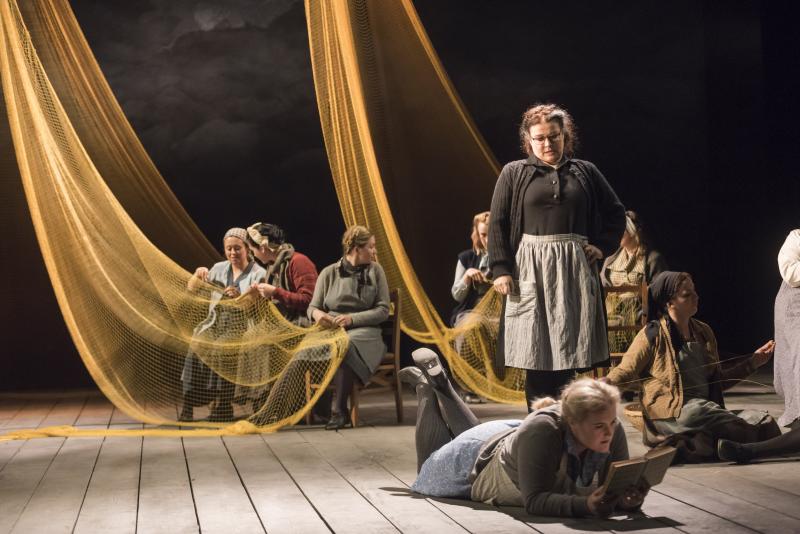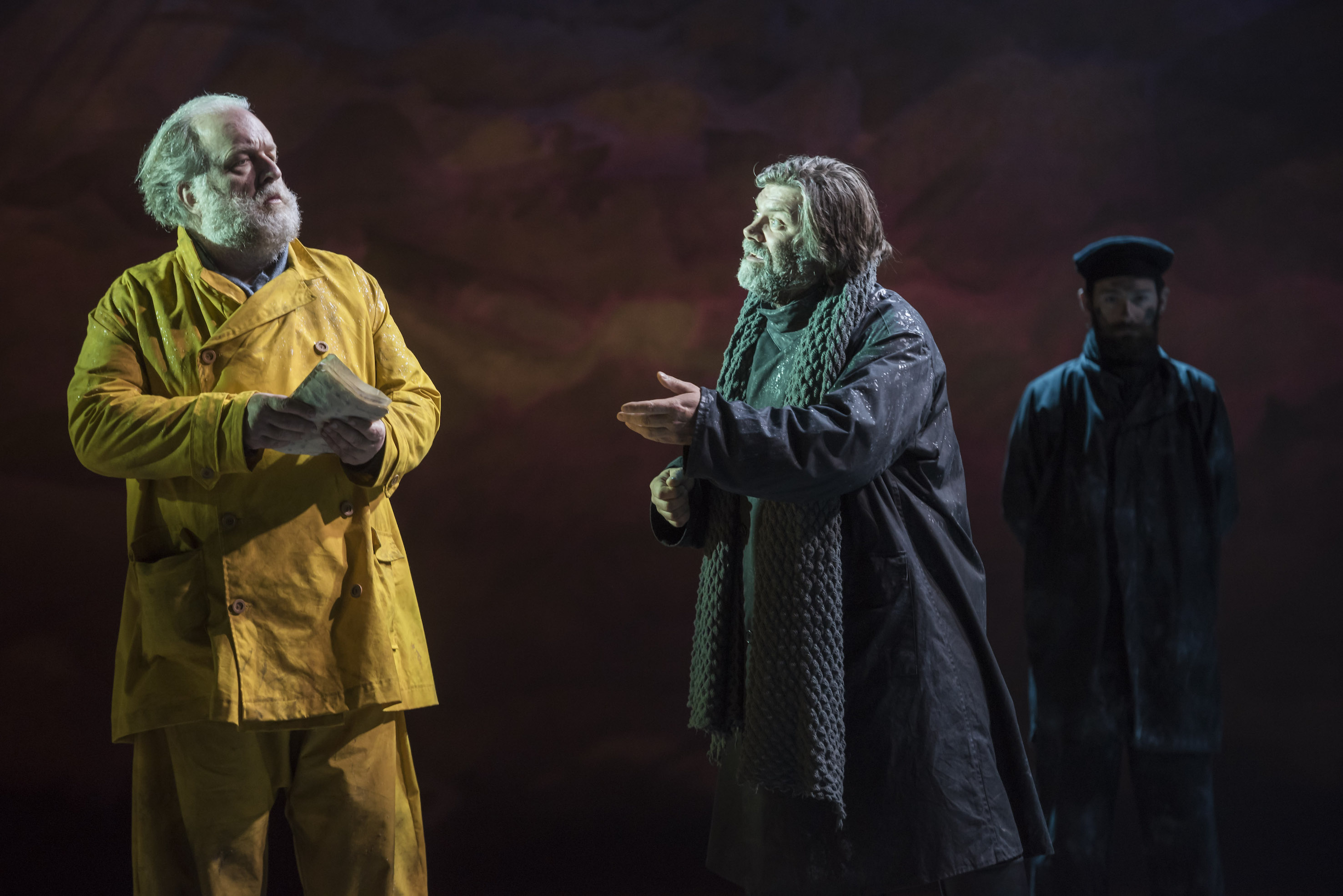Der fliegende Holländer, Longborough Festival review - stand and deliver on an empty stage | reviews, news & interviews
Der fliegende Holländer, Longborough Festival review - stand and deliver on an empty stage
Der fliegende Holländer, Longborough Festival review - stand and deliver on an empty stage
Wagner's early brilliance dimmed by patchy singing and plodding direction

Brilliant and innovative though it is in many respects, The Flying Dutchman is by no means a straightforward piece to stage. It’s an odd, sometimes uncomfortable mixture of the genre and the epic. At Sadler’s Wells in the sixties they had a little ship and a big ship that hove into view, a fishing village, sailors with tankards and striped shirts, and girls at looms.
Now, at Longborough, Thomas Guthrie and his designer, Ruth Paton, have neither ships nor mental home, no village (apart from a few model houses against the last act backcloth), a painted ocean (of sorts), a few girls making, or mending, nets, and above all no sign of the Dutchman’s portrait, which one might think the one prop sine qua non, mentioned countless times, and the chief engine of the plot. Instead Senta sits during the overture looking at what might be his picture in a book; later Mary (Senta’s old nurse, here recast as the girls’ overseer) tears it up; later still Erik seems to produce another copy. We the audience never see it. Finally, there being no cliff to jump off, Senta stabs herself on the empty stage and the Dutchman reappears like Pinkerton, apparently redeemed simply because Wagner - in his serene D major - says he is.
In short, this is a blank staging, a tabula rasa, which throws all its weight on to the individual characters: Daland, the bluff, mercenary sea captain, his daughter Senta, the dreamy fantasist, Erik, the lovelorn hunter, and the Dutchman himself, Faust in sea boots. This might work if the staging itself were more responsive to the conflicts that already begin to show Wagner’s genius for psychological theatre. But Guthrie is, let’s say, inclined to be discreet in this respect.
One longs for a more fluid interaction between these unhappy personalitiesAs in his Marriage of Figaro here a couple of years ago, he favours the stand-and-deliver aria mode, face front, and no distracting movement. There are occasional exceptions, but the general effect is wooden, statuesque. One longs for a more fluid interaction between these unhappy personalities. Even the sailors in Wagner’s astonishing last act chorus (something he later decried in Opera and Drama) simply face the audience and bounce up and down. They sing with vigour, if not exceptional refinement. But Wagner’s deep dramatic polyphonies deserve something more.
I’m about to say, of course, that the music redeems all under the dependable Anthony Negus. But alas not, or at least not yet. Kirstin Sharpin is a radiant, fresh-voiced Senta, though a stodgy actress, and there is a personable, energetically sung Erik from Jonathan Stoughton, who craved indulgence for some illness or other but hardly showed it. William Wallace sings the Steersman’s song solidly if not quite prettily, leaning on the proscenium arch. But the all-important bass singing leaves a good deal to be desired. Simon Thorpe (pictured above, right, with Richard Wiegold) is a versatile performer, but here, in what I take to be his first major Wagner role, he tends to force, with damaging effects on his intonation. Richard Wiegold has no need to force as Daland: his is a huge vibrant bass, marred though by coarse phrasing and occasionally rough production. Maybe this is his way of “being” Daland, but if so it does the music, in Wagner’s old-fashioned lyrical vein, less than justice.
But the all-important bass singing leaves a good deal to be desired. Simon Thorpe (pictured above, right, with Richard Wiegold) is a versatile performer, but here, in what I take to be his first major Wagner role, he tends to force, with damaging effects on his intonation. Richard Wiegold has no need to force as Daland: his is a huge vibrant bass, marred though by coarse phrasing and occasionally rough production. Maybe this is his way of “being” Daland, but if so it does the music, in Wagner’s old-fashioned lyrical vein, less than justice.
Negus’s reading (the first two acts joined, as in the original score, the third act separate to allow a dinner interval) is on the slow side and a shade cautious. Problems of ensemble suggest under-preparation, most unusually for him, but after all he can’t force the singers to watch and listen. Even the orchestral playing has its rough edges, especially in the woodwind writing, one of the score’s important innovations. But these are one hopes teething troubles. If only the production could be got moving, its lack of specificity would matter less and the music would benefit.
rating
Share this article
Add comment
The future of Arts Journalism
You can stop theartsdesk.com closing!
We urgently need financing to survive. Our fundraising drive has thus far raised £49,000 but we need to reach £100,000 or we will be forced to close. Please contribute here: https://gofund.me/c3f6033d
And if you can forward this information to anyone who might assist, we’d be grateful.

Subscribe to theartsdesk.com
Thank you for continuing to read our work on theartsdesk.com. For unlimited access to every article in its entirety, including our archive of more than 15,000 pieces, we're asking for £5 per month or £40 per year. We feel it's a very good deal, and hope you do too.
To take a subscription now simply click here.
And if you're looking for that extra gift for a friend or family member, why not treat them to a theartsdesk.com gift subscription?
more Opera
 Orpheus and Eurydice, Opera Queensland/SCO, Edinburgh International Festival 2025 review - dazzling, but distracting
Eye-popping acrobatics don’t always assist in Gluck’s quest for operatic truth
Orpheus and Eurydice, Opera Queensland/SCO, Edinburgh International Festival 2025 review - dazzling, but distracting
Eye-popping acrobatics don’t always assist in Gluck’s quest for operatic truth
 MARS, Irish National Opera review - silly space oddity with fun stretches
Cast, orchestra and production give Jennifer Walshe’s bold collage their all
MARS, Irish National Opera review - silly space oddity with fun stretches
Cast, orchestra and production give Jennifer Walshe’s bold collage their all
 Káťa Kabanová, Glyndebourne review - emotional concentration in a salle modulable
Janáček superbly done through or in spite of the symbolism
Káťa Kabanová, Glyndebourne review - emotional concentration in a salle modulable
Janáček superbly done through or in spite of the symbolism
 Buxton International Festival 2025 review - a lavish offering of smaller-scale work
Allison Cook stands out in a fascinating integrated double bill of Bernstein and Poulenc
Buxton International Festival 2025 review - a lavish offering of smaller-scale work
Allison Cook stands out in a fascinating integrated double bill of Bernstein and Poulenc
 Tosca, Clonter Opera review - beauty and integrity in miniature
Happy surprises and a convincing interpretation of Puccini for today
Tosca, Clonter Opera review - beauty and integrity in miniature
Happy surprises and a convincing interpretation of Puccini for today
 Hamlet, Buxton International Festival review - how to re-imagine re-imagined Shakespeare
Music comes first in very 19th century, very Romantic, very French operatic creation
Hamlet, Buxton International Festival review - how to re-imagine re-imagined Shakespeare
Music comes first in very 19th century, very Romantic, very French operatic creation
 Falstaff, Glyndebourne review - knockabout and nostalgia in postwar Windsor
A fat knight to remember, and snappy stagecraft, overcome some tedious waits
Falstaff, Glyndebourne review - knockabout and nostalgia in postwar Windsor
A fat knight to remember, and snappy stagecraft, overcome some tedious waits
 Salome, LSO, Pappano, Barbican review - a partnership in a million
Asmik Grigorian is vocal perfection in league with a great conductor and orchestra
Salome, LSO, Pappano, Barbican review - a partnership in a million
Asmik Grigorian is vocal perfection in league with a great conductor and orchestra
 Semele, Royal Opera review - unholy smoke
Style comes and goes in a justifiably dark treatment of Handelian myth
Semele, Royal Opera review - unholy smoke
Style comes and goes in a justifiably dark treatment of Handelian myth
 Le nozze di Figaro, Glyndebourne review - perceptive humanity in period setting
Mostly glorious cast, sharp ideas, fussy conducting
Le nozze di Figaro, Glyndebourne review - perceptive humanity in period setting
Mostly glorious cast, sharp ideas, fussy conducting
 Fidelio, Garsington Opera review - a battle of sunshine and shadows
Intimacy yields to spectacle as Beethoven's light of freedom triumphs
Fidelio, Garsington Opera review - a battle of sunshine and shadows
Intimacy yields to spectacle as Beethoven's light of freedom triumphs
 Dangerous Matter, RNCM, Manchester review - opera meets science in an 18th century tale
Big doses of history and didaction are injected into 50 minutes of music theatre
Dangerous Matter, RNCM, Manchester review - opera meets science in an 18th century tale
Big doses of history and didaction are injected into 50 minutes of music theatre

Comments
This way too downbeat review